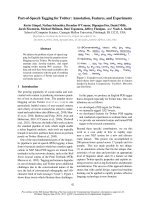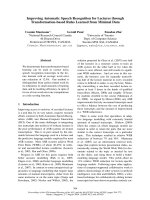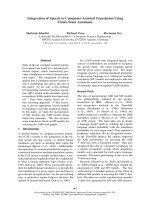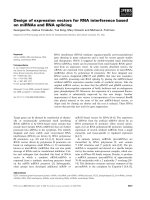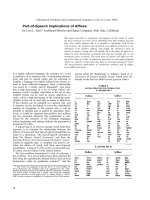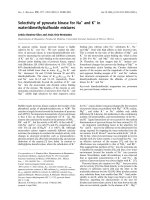Báo cáo khoa học: "Part of Speech Tagger for Assamese Text" docx
Bạn đang xem bản rút gọn của tài liệu. Xem và tải ngay bản đầy đủ của tài liệu tại đây (117.57 KB, 4 trang )
Proceedings of the ACL-IJCNLP 2009 Conference Short Papers, pages 33–36,
Suntec, Singapore, 4 August 2009.
c
2009 ACL and AFNLP
Part of Speech Tagger for Assamese Text
Navanath Saharia
Department of CSE
Tezpur University
India - 784028
Dhrubajyoti Das
Department of CSE
Tezpur University
India - 784028
{nava tu,dhruba it06,utpal}@tezu.ernet.in
Utpal Sharma
Department of CSE
Tezpur University
India - 784028
Jugal Kalita
Department of CS
University of Colorado
Colorado Springs - 80918
Abstract
Assamese is
a morphologically rich, agglutinative and
relatively free word order Indic language.
Although spoken by nearly 30 million
people, very little computational linguistic
work has been done for this language. In
this paper, we present our work on part
of speech (POS) tagging for Assamese
using the well-known Hidden Markov
Model. Since no well-defined suitable
tagset was available, we develop a tagset
of 172 tags in consultation with experts
in linguistics. For successful tagging,
we examine relevant linguistic issues in
Assamese. For unknown words, we
perform simple morphological analysis
to determine probable tags. Using a
manually tagged corpus of about 10000
words for training, we obtain a tagging
accuracy of nearly 87% for test inputs.
1 Introduction
Part of Speech (POS) tagging is the process of
marking up words and punctuation characters in
a text with appropriate POS labels. The problems
faced in POS tagging are many. Many words that
occur in natural language texts are not listed in any
catalog or lexicon. A large percentage of words
also show ambiguity regarding lexical category.
The challenges of our work on POS tagging
for Assamese, an Indo-European language, are
compounded by the fact that very little prior
computational linguistic exists for the language,
though it is a national language of India and
spoken by over 30 million people. Assamese is a
morphologically rich, free word order, inflectional
language. Although POS tagged annotated
corpus for some of the Indian languages such as
Hindi, Bengali, and Telegu (SPSAL, 2007) have
become available lately, a POS tagged corpus for
Assamese was unavailable till we started creating
one for the work presented in this paper. Another
problem was that a clearly defined POS tagset for
Assamese was unavailable to us. As a part of the
work reported in this paper, we have developed
a tagset consisting of 172 tags, using this tagset
we have manually tagged a corpus of about ten
thousand Assamese words.
In the next section we provide a brief relevant
linguistic background of Assamese. Section 3
contains an overview of work on POS tagging.
Section 4 describes our experimental setup. In
Section 5, we analyse the result of our work
and compare the performance with other models.
Section 6 concludes this paper.
2 Linguistic Characteristics of Assamese
In Assamese, secondary forms of words are
formed through three processes: affixation,
derivation and compounding. Affixes play a very
important role in word formation. Affixes are used
in the formation of relational nouns and pronouns,
and in the inflection of verbs with respect to
number, person, tense, aspect and mood. For
example, Table 1 shows how a relational noun
(deutA: father) is inflected depending on
number and person (Goswami, 2003). Though
Assamese is relatively free word order, yet the
predominant word order is subject-object-verb
(SOV).
The following paragraphs describe just a few
of the many characteristics of Assamese text that
make the tagging task complex.
• Depending on the context, even a common
word may have different
POS tags. For example: If (kArane),
(dare), (nimitte), (hetu), etc.,
are placed after pronominal adjective, they
are considered conjunction and if placed after
33
Table 1: Personal definitives are inflected on
person and number
Person Singular Plural
1
st
My father Our father
mor deutA aAmAr deutA
2
nd
Your father Your father
tomAr deutArA tomAlokar deutArA
2
nd
, Familiar Your father Your father
tor deutAr tahator deutAr
3
rd
Her father Their father
tAir deutAk sihator deutAk
noun or personal pronoun they are considered
particle. For example,
TF
1
: ei kArane moi nagalo.
This + why + I+ did not go.
ET
2
: This is why I did not go.
TF : rAmar kArane moi nagalo.
Ram’s + because of + I + did not go
ET : I did not go because of Ram.
In the first sentence (kArne) is placed
after pronominal adjective (ei); so kArne
is considered conjunction. But in the
second sentence kArne is placed after noun
(RAm), and hence kArne is considered
particle.
• Some prepositions or particles are used as
suffix if they occur after noun, personal
pronoun or verb. For example,
TF: sihe goisil.
ET : Only he went.
Actually (he : only) is a particle, but it is
merged with the personal pronoun (si).
• An affix denoting number, gender or person,
can be added to an adjective or other category
word to create a noun word. For example,
TF : dhuniyAjoni hoi aAhisA.
ET : You are looking beautiful.
Here (dhuniyA : beautiful) is an
adjective, but after adding feminine suffix
the whole constituent becomes a noun word.
1
TF : Transliterated Assamese Form
2
ET : Aproximate English Translation
• Even conjunctions can be used as other part
of speech.
TF : Hari aAru Jadu bhAyek kokAyek.
ET : Hari and Jadu are brothers.
TF : JowAkAli rAtir ghotonAtowe bishoitok
aAru adhik rahashyajanak kori tulile.
ET : The last night incident has made the
matter more mysterious.
The word (aAru : and) shows ambiguity
in these two sentences. In the first, it is used
as conjunction (i.e. Hari and Jadu) and in the
second, it is used as adjective of adjective.
3 Related Work
Several approaches have been used for building
POS taggers. Two main approaches are
supervised and unsupervised. Both supervised and
unsupervised tagging can be of three sub-types.
They are rule based, stochastic based and neural
network based. There are number of pros and cons
for each of these methods. The most common
stochastic tagging technique is Hidden Markov
Model (HMM).
During the last two
decades, many different types of taggers have been
developed, especially for corpus rich languages
such as English. Nevertheless, due to relatively
free word order, agglutinative nature, lack of
resources and the general lateness in entering the
computational linguistics field in India, reported
tagger development work on Indian languages
is relatively scanty. Among reported works,
Dandapat (2007) developed a hybrid model of
POS tagging by combining both supervised and
unsupervised stochastic techniques. Avinesh and
Karthik (2007) used conditional random field and
transformation based learning. The heart of the
system developed by Singh et al. (2006) for Hindi
was the detailed linguistic analysis of morpho-
syntactic phenomena, adroit handling of suffixes,
accurate verb group identification and learning
of disambiguation rules. Saha et al. (2004)
developed a system for machine assisted POS
tagging of Bangla corpora. Pammi and Prahllad
(2007) developed a POS tagger and chunker
using Decision Forests. This work explored
different methods for POS tagging of Indian
languages using sub-words as units. Generally,
most POS taggers for Indian langauages use
34
morphological analyzer as a module. However,
building morphological analyzer of a particular
Indian language is a very difficult task.
4 Our Approach
We have used a Assamese text corpus (Corpus
Asm) of nearly 300,000 words from the online
version of the Assamese daily Asomiya Pratidin
(Sharma et al., 2008). The downloaded articles
use a font-based encoding called Luit. For
our experiments we transliterate the texts to a
normalised Roman encoding using transliteration
software developed by us. We manually tag a
part of this corpus, Tr, consisting of nearly 10,000
words for training. We use other portions of
Corpus Asm for testing the tagger.
There was no tagset for Assamese before we
started the project reported in this paper. Due to
the morphological richness of the language, many
words of Assamese occur in secondary forms in
texts. This increases the number of POS tags
that needed for the language. Also, often there
are differences of opinion among linguists on the
tags that may be associated with certain words
in texts. We developed a tagset after in-depth
consultation with linguists and manually tagged
text segments of nearly 10,000 words according to
their guidance. To make the tagging process easier
we have subcategorised each category of noun
and personal pronoun based on six case endings
(viz, nominative, accussative, instumental, dative,
genitive and locative) and two numbers.
We have used HMM
(Dermatas and Kokkinakis, 1995) and the Viterbi
algorithm (1967) in developing our POS tagger.
HMM/Viterbi approach is the most useful method,
when pretagged corpus is not available. First, in
the training phase, we have manually tagged the
Tr part of the corpus using the tagset discussed
above. Then, we build four database tables
using probabilities extracted from the manually
tagged corpus- word-probability table, previous-
tag-probability table, starting-tag-probability table
and affix-probability table.
For testing, we consider three text segments, A,
B and C, each of about 1000 words. First the input
text is segmented into sentences. Each sentence
is parsed individually. Each word of a sentence
is stored in an array. After that, each word is
searched in the word-probability table. If the
word is unknown, its possible affixes are extracted
Table 2: POS tagging results with small corpora.
Size of training words : 10000, UWH : Unknown word
handling, UPH : Unknown proper noun handling
Test Size Average UDH UPH
set accuracy accuracy accuracy
A 992 84.68% 62.8% 42.0%
B 1074 89.94% 67.54% 53.96%
C 1241 86.05% 85.64% 26.47%
Table 3: Comparison of our result with other
HMM based model.
Author Language Average
accuracy
Toutanova et al.(2003) English 97.24%
Banko and Moore(2004) English 96.55%
Dandapat and Sarkar(2006) Bengali 84.37%
Rao et al.(2007)
Hindi 76.34%
Bengali 72.17%
Telegu 53.17%
Rao and Yarowsky(2007)
Hindi 70.67%
Bengali 65.47%
Telegu 65.85%
Sastry et al.(2007)
Hindi 69.98%
Bengali 67.52%
Telegu 68.32%
Ekbal et al.(2007)
Hindi 71.65%
Bengali 80.63%
Telegu 53.15%
Ours Assamese 85.64%
and searched in the affix-probability table. From
this search, we obtain the probable tags and
their corresponding probabilities for each word.
All these probable tags and the corresponding
probabilities are stored in a two dimensional array
which we call the lattice of the sentence. If we
do not get probable tags and probabilities for a
certain word from these two tables we assign tag
CN (Common Noun) and probability 1 to the
word since occurrence of CN is highest in the
manually tagged corpus. After forming the lattice,
the Viterbi algorithm is applied to the lattice that
yields the most probable tag sequence for that
sentence. After that next sentence is taken and the
same procedure is repeated.
5 Experimental Evaluation
The results using the three test segments are
summarised in Table 2. The evaluation of the
results require intensive manual verification effort.
Larger training corpora is likely to produce more
accurate results. More reliable results can be
obtained using larger test corpora. Table 3
compares our result with other HMM based
reported work. Form the table it is clear that
35
Toutanova et al. (2003) obtained the best result
for English (97.24%). Among HMM based
experiments reported on Indian languages, we
have obtained the best result (86.89%). This work
is ongoing and the corpus size and the amount of
tagged text are being increased on a regular basis.
The accuracy of a tagger depends on the size of
tagset used, vocabulary used, and size, genre and
quality of the corpus used. Our tagset containing
172 tags is rather big compared to other Indian
language tagsets. A smaller tagset is likely to
give more accurate result, but may give less
information about word structure and ambiguity.
The corpora for training and testing our tagger are
taken form an Assamese daily newspaper Asomiya
Pratidin, thus they are of the same genre.
6 Conclusion & Future work
We have achieved good POS tagging results for
Assamese, a fairly widely spoken language which
had very little prior computational linguistic work.
We have obtained an average tagging accuracy
of 87% using a training corpus of just 10000
words. Our main achievement is the creation of
the Assamese tagset that was not available before
starting this project. We have implemented an
existing method for POS tagging but our work is
for a new language where an annotated corpora
and a pre-defined tagset were not available.
We are currently working on developing a
small and more compact tagset. We propose
the following additional work for improved
performance. First, the size of the manually
tagged part of the corpus will have to be
increased. Second, a suitable procedure for
handling unknown proper nouns will have to be
developed. Third, if this system can be expanded
to trigrams or even n-grams using a larger training
corpus, we believe that the tagging accuracy will
increase.
Acknowledgemnt
We would like to thank Dr. Jyotiprakash Tamuli,
Dr. Runima Chowdhary and Dr. Madhumita
Barbora for their help, specially in making the
Assamese tagset.
References
Avinesh PVS & Karthik G. POS tagging and chunking using
Conditional Random Field and Transformation based
learning. IJCAI-07 workshop on Shallow Parsing for
South Asian Languages. 2007.
Banko, M., & Robert Moore, R. Part of speech tagging in
context. 20th International Conference on Computational
Linguistics. 2004.
Dandapat, S. Part-of-Speech Tagging and Chunking with
Maximum Entropy Model. Workshop on Shallow Parsing
for South Asian Languages. 2007.
Dandapat, S., & Sarkar, S. Part-of-Speech Tagging for
Bengali with Hidden Markov Model. NLPAI ML
workshop on Part of speech tagging and Chunking for
Indian language. 2006.
Dermatas, S., & Kokkinakis, G. Automatic stochastic
tagging of natural language text. Computational
Linguistics 21 : 137-163. 1995.
Ekbal, A., Mandal, S., & Bandyopadhyay, S. POS tagging
using HMM and rule based chunking . Workshop on
Shallow Parsing for South Asian Languages. 2007.
Goswami, G. C. Asam
¯
iy
¯
a Vy
¯
akaran
.
Pravesh, Second edition.
Bina Library, Guwahati. 2003.
IJCAI-07 workshop on
Shallow Parsing for South Asian Languages. Hyderabad,
India.
Pammi, S.C., & Prahallad, K. POS tagging and chunking
using Decision Forests. Workshop on Shallow Parsing for
South Asian Languages. 2007.
Rao, D., & Yarowsky, D Part of speech tagging and
shallow parsing of Indian languages. IJCAI-07 workshop
on Shallow Parsing for South Asian Languages. 2007.
Rao, P.T., & Ram, S.R., Vijaykrishna, R. & Sobha L. A
text chunker and hybrid pos tagger for Indian languages.
IJCAI-07 workshop on Shallow Parsing for South Asian
Languages. 2007.
Saha, G.K., Saha, A.B., & Debnath, S. Computer
Assisted Bangla Words POS Tagging. Proc. International
Symposium on Machine Translation NLP & TSS. 2004.
Sastry, G.M.R., Chaudhuri, S., & Reddy, P.N. A HMM
based part-of-speech and statistical chunker for 3 Indian
languages. IJCAI-07 workshop on Shallow Parsing for
South Asian Languages. 2007.
Sharma, U., Kalita, J. & Das, R. K. Acquisition of
Morphology of an Indic language from text corpus. ACM
TALIP 2008.
Singh, S., Gupta K., Shrivastava, M., & Bhattacharyya,
P. Morphological richness offsets resource demand-
experiences in constructing a POS tagger for Hindi.
COLING/ACL. 2006.
Toutanova, K., Klein, D., Manning, C.D. & Singer,
Y. Feature-Rich part-of-speech tagging with a Cyclic
Dependency Network. HLT-NAACL. 2003.
Viterbi, A.J. Error bounds for convolutional codes and
an asymptotically optimum decoding algorithm. IEEE
Transaction on Information Theory 61(3) : 268-278.
1967.
36


